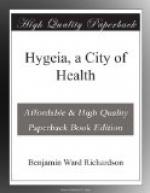Two additional conveniences are supplied by the scientific work of the sanitary establishment. From steam-works steam is condensed, and a large supply of distilled water is obtained and preserved in a separate tank. This distilled water is conveyed by a small main into the city, and is supplied at a moderate cost for those domestic purposes for which hard water is objectionable.
The second sanitary convenience is a large ozone generator. By this apparatus ozone is produced in any required quantity, and is made to play many useful purposes. It is passed through the drinking water in the reserve reservoir whenever the water shows excess of organic impurity, and it is conveyed into the city for diffusion into private houses, for purposes of disinfection.
The slaughter-houses of the city are all public, and are separated by a distance of a quarter of a mile from the city. They are easily removable edifices, and are under the supervision of the sanitary staff. The Jewish system of inspecting every carcase that is killed is rigorously carried out, with this improvement, that the inspector is a man of scientific knowledge.
All animals used for food,—cattle, fowls, swine, rabbits,—are subjected to examination in the slaughter-house, or in the market, if they be brought into the city from other depots. The slaughter-houses are so constructed that the animals killed are relieved from the pain of death. They pass through a narcotic chamber, and are brought to the slaughterer oblivious of their fate. The slaughter-houses drain into the sewers of the city, and their complete purification daily, from all offal and refuse, is rigidly enforced.
The buildings, sheds, and styes for domestic food-producing animals are removed a short distance from the city, and are also under the supervision of the sanitary officer; the food and water supplied for these animals comes equally, with human food, under proper inspection.
One other subject only remains to be noticed in connection with the arrangements of our model city, and that is the mode of the disposal of the dead. The question of cremation and of burial in the earth has been considered, and there are some who advocate cremation. For various reasons the process of burial is still retained. Firstly, because the cremation process is open to serious medico-legal objections; secondly, because, by the complete resolution of the body into its elementary and inodorous gases in the cremation furnace, that intervening chemical link between the organic and inorganic worlds, the ammonia, is destroyed, and the economy of nature is thereby dangerously disturbed; thirdly, because the natural tendencies of the people lead them still to the earth, as the most fitting resting-place into which, when lifeless, they should be drawn.




